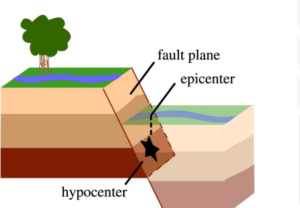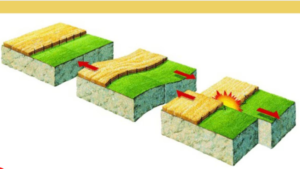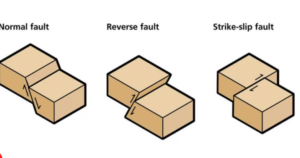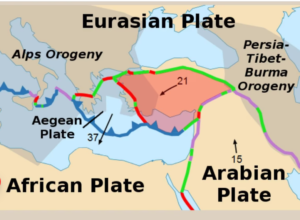Published on: February 8, 2023
Earthquake
Earthquake
Why in news? The magnitude 7.8 earthquake that struck Turkey and Syria is likely to be one of the deadliest this decade, with a more than 100 km (62 miles) rupture between the Anatolian and Arabian plates.
Highlights
- The catastrophic earthquake which struck Turkey is unique not only because of its huge magnitude, but also because the events leading up to it occurred within the East Anatolian fault system, where major earthquakes have not occurred in the past
The science behind earthquakes
- Sudden movement along faults within the Earth causes earthquakes due to the release of stored-up ‘elastic strain’ energy in the form of seismic waves.
- Elastic strain energy refers to the energy stored in a structure due to its elastic deformation.
- The elastic strain energy released in the form of seismic waves propagates through the Earth and causes the ground to shake.
- Such movement on the faults or fault lines is generally a response to long-term deformation and the buildup of stress.
- The location below the Earth’s surface where an earthquake begins is called the hypocentre, while the location directly above it on the surface of the Earth is called the epicenter
What are tectonic plates?
- The Earth’s outermost layer, also called the lithosphere, is composed of the crust (continental and oceanic), and the upper part of the mantle, and is fragmented into about 15 major slabs called tectonic plates.
- Tectonic plates form the lithosphere, and move very slowly relative to each other, typically a few centimetres each year.
- These movements result in a huge amount of deformation at the edges of tectonic plates, called plate boundaries, and this, in turn, leads to earthquakes.
What causes earthquakes?
- Most of the earthquakes around the world occur on faults, which the plate boundaries are made up
- When the plates move against each other, the edges get stuck because they are rough, after the plate has moved far enough, the edges unstick on one of the faults. This is results in an earthquake.
What are the different types of faults?
There are three basic types of fault, namely, normal fault, reverse fault and strike-slip fault.

- A particular plate boundary can have more than one type of fault.
- When the block above the fault moves down relative to the block below the fault, it is called a normal fault.
- A reverse fault is one in which the block above the fault moves up relative to the block below the fault.
- A strike-slip fault is one in which the movement of blocks along a fault is horizontal.
- Turkey’s devastating earthquake occurred along long, plate-boundary strike-slip faults.
- The rock on one side of the fault suddenly slips with respect to the other, when an earthquake takes place.
Why is Turkey so vulnerable to earthquakes?
- In the vicinity of the East Anatolian fault system is a triple junction, which is a tectonically active area.
- Three tectonic plates, namely the African Plate, Arabian Plate and Eurasian Plate, touch and interact with each other, and also with the Anatolian Plate, which lies in the centre.
- The Anatolian Plate is situated in Turkey and forms part of a complex and active system of tectonic activity in the region with its surrounding plates.

- The North Anatolian fault system, which is the east-west continental transform fault situated in northern Turkey, separating the Eurasian Plate and the Anatolian Plate, produces persistent earthquake activity along the fault.

